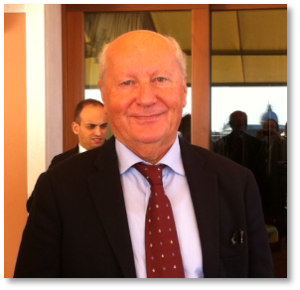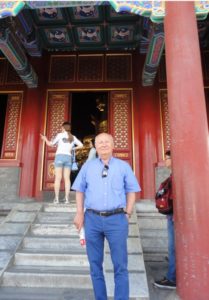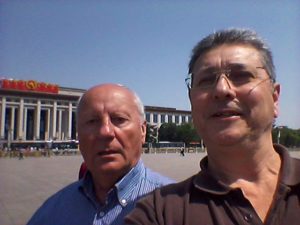From molecular biology to human retroviruses: in memory of GVN Italy Center Director Umberto Bertazzoni (1937-2020)

Born in Trissino (VI) in 1937, Umberto Bertazzoni graduated from the University of Pavia in Pharmacy (1960) and in Biological Sciences (1964). He was a researcher at the Joint Research Center of Ispra from 1964 to 1974, researcher at the Institute of Genetics of the CNR of Pavia from 1974 to 1994 and Head of Unit at the Directorate General for Research of the European Commission in Brussels from 1995 to 2000. He also carried out research activity in 1962 at the University of Iowa, USA; from 1971 to 1974 at the J. Monod Institute of the University of Paris VII; in 1979 and 1992 at the Naval Hospital and the NIH in Bethesda, USA. He was full professor of Molecular Biology at the University of Verona from 1990 to 2010 in the degree course of Medicine and Surgery. Prof. Bertazzoni was a Center of Excellence Director of the Global Virus Network (GVN) Italy. He authored of 110 indexed publications (h-index: 28; source. Scopus).
Prof. Umberto Bertazzoni received the “Giovanna Tosi” Prize for Cancer Research at the University of Insubria in September 2018 “For his seminal studies on human oncogenic retroviruses and for his tireless activity in foundation and support of international virology Institutions” which perfectly summarizes his long scientific life, recalls Luigi “Gino” Chieco-Bianchi (University of Padua), perhaps his closest friend, as well as collaborator and first Director of GVN Italy.

Umberto Bertazzoni in Red Square, Beijing, China during GVN’s 2015 International Meeting
Prof. Chieco-Bianchi continued, “I met Umberto in the early 1980s when, an established researcher at ISPRA (Higher Institute for Environmental Protection and Research), he dealt with the molecular mechanisms underlying the proliferation of neoplastic cells . With the advent of AIDS, his skills in enzymology became invaluable for the study of reverse transcriptase, the key enzyme of retroviruses such as HIV (human immunodeficiency virus, cause of AIDS) and HTLV (human T lymphotropic virus, the first pathogenic human retrovirus, discovered in 1980, and causative agent of a relatively rare form of adult T-cell leukemia and neurological syndromes). Umberto immediately became part of the group of “human retrovirologists”, initially not very numerous – which I too had joined in after abandoning my studies on murine retroviruses – soon conquering a leading position in the study of HTLV. Those were years of intense and enthusiastic work: many young scholars, who returned from the USA and various European countries, where they had acquired new skills, were recruited together with the most valid Italian research groups in the National AIDS Project, adequately funded by the Ministry of Health and managed by the Istituto Superiore di Sanità under the intelligent and rigorous scientific direction of Giovanni Battista Rossi. Umberto participated assiduously in the periodic meetings, very animated, in which the various Operational Units of the Project reported the results achieved, thanks to which Italy in those years established itself among the leading countries for AIDS research.”
In the mid-1990s he took on an important position at the EU Research Directorate General where he was also head of the Infectious Diseases section, coordinating among other things the European projects on AIDS. The main focus of his research was the study of the characteristics of HTLV-2 (a substantially non-pathogenic virus for humans) and of its molecular and functional differences compared to HTLV-1 (absent in Italy) with the intent to clarify the absence of oncogenicity observed in infected individuals, in general drug addicts or former drug addicts. The results of these studies have been the subject of relevant publications, as evidenced by having been editor (with Vincenzo Ciminale of the University of Padua and Maria Grazia Romanelli, his close collaborator at the University of Verona) of a monographic issue of Frontiers of Microbiology dedicated to HTLV-1 (3).

Luigi “Gino” Chieco-Bianchi and and Umberto Bertazzoni
Prof. Chieco-Bianchi said, “With Umberto I also shared the adventure of the Global Virus Network (GVN), founded in Washington in 2011 by Bob Gallo of the U.S., Billy Hall of Ireland and the late Reinhardt Kurth of Germany. Bob wanted me to initially be the coordinator of the Italian Center of Excellence and so, with Umberto, Roberto Accolla, Franco and Luigi Buonaguro, Beppe Ippolito and Guido Poli, all armed with goodwill but lacking operational resources, we began to set up that involved old and young Italian virologists. After three years, due to physiological turnover, Umberto was unanimously designated to lead GVN Italy and for another three years, more effectively, he carried out his coordinating role, always animated by enthusiasm and confidence in the future.
Prof. Robert Gallo (Institute of Human Virology, University of Maryland School of Medicine, Baltimore, Maryland, USA, Global Virus Network): “Umberto Bertazzoni was a scientific close colleague and personal friend for four decades. I always enjoyed his company and his wonderful enthusiasm for our similar scientific interests. He was early in HTLV research and some of its pioneering studies. He was a leader in the early formation of the GVN and instrumental in its activities. He will be missed very much, but always remembered.”
Prof. Guido Poli (Vita-Salute San Raffaele University, Milan, Global Virus Network): “Immediately after his return to the University of Verona, a relationship of collaboration and friendship emerged largely mediated by his collaborator Claudio Casoli who also left us a few months ago. The intersection of our scientific interests was based on HIV-1 and HTLV-2 co-infection, mainly in drug addicts or ex-drug addicts. Keen to our scientific collaboration was the discovery in 1995-1996 of the fundamental role of CCR5-binding chemokines (and to a lesser extent CXCR4), a key receptor for HIV-1 entry into target cells. Not surprisingly, the study by Paolo Lusso and Robert Gallo of December 1995 (4) exploited the production of these chemokines by T lymphocytes immortalized by HTLV-1 or HTLV-2. We then demonstrated together with Umberto, Claudio and their collaborators that patients co-infected with HTLV-2 and HIV-1 often had the characteristics of Long-Term Non-Progressors, that is, they demonstrated a natural predisposition to control the progression of HIV-1 disease, thanks to the hyperproduction of a particularly powerful chemokine (5). Beyond his objective scientific merits, with Umberto Bertazzoni disappears one of the last ‘gentlemen scientists’ around.”

Umberto Bertazzoni and Guido Poli in Red Square, Beijing, China during GVN’s 2015 International Meeting
Prof. Davide Zella (Institute of Human Virology, University of Maryland School of Medicine, Baltimore, Maryland, USA, Global Virus Network): “I met Umberto in 1984, at the CNR in Pavia, as a young university student. Life in his laboratory was very pleasant: I was learning and having fun. I remember the time spent discussing science, and he would have guided me towards the thesis. At the beginning he was ‘the professor,’ but he quickly became ‘Umberto,’ a friend who over time would have given me advice, at times assuming the appearance of a father figure. With the arrival of AIDS, Umberto introduced me to Robert Gallo in Florence in 1992 and from there my career began with Gallo, with whom I still work today. Umberto taught me a lot, in the laboratory and in life, and I will miss him very much.”
Franco M. Buonaguro (“Center Director”), Roberto Accolla, Luigi Buonaguro, Gino Chieco-Bianchi, Giuseppe Ippolito & Guido Poli for GVN-Italy.
References
- Bertazzoni U, Stefanini M, Noy GP, Giulotto E, Nuzzo F, Falaschi A et al. Variations of DNA polymerase-alpha and -beta during prolonged stimulation of human lymphocytes. Proc Natl Acad Sci U S A. 1976; 73 (3): 785-9
- Bertazzoni U, Brusamolino E, Isernia P, Scovassi AI, Torsello S, Lazzarino M et al. Prognostic significance of terminal transferase and adenosine deaminase in acute and chronic myeloid leukemia. Blood. 1982; 60 (3): 685-92
- Bertazzoni U, Ciminale V, Romanelli MG. Editorial: Molecular Pathology of HTLV-1. Front Microbiol. 2018; 9: 3069
- Cocchi F, DeVico AL, Garzino-Demo A, Arya SK, Gallo RC, Lusso P. Identification of RANTES, MIP-1 alpha, and MIP-1 beta as the major HIV-suppressive factors produced by CD8 + T cells. Science. 1995; 270 (5243): 1811-5
- Pilotti E, Elviri L, Vicenzi E, Bertazzoni U, Re MC, Allibardi S et al. Postgenomic up-regulation of CCL3L1 expression in HTLV-2-infected persons curtails HIV-1 replication. Blood. 2007; 109 (5): 1850-6
